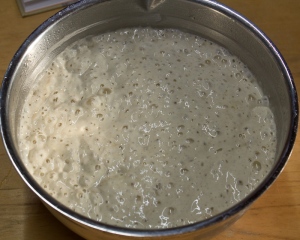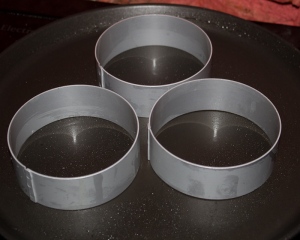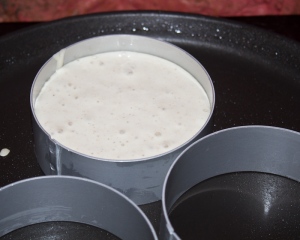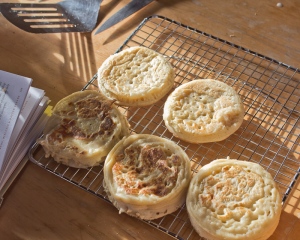Well, that was interesting. “Interesting” as in “nowhere near as easy as I had expected it to be.”

Making the batter was simple and fast – just whisk together the flour, yeast, milk and water. I used a balloon whisk, forgetting that I have a spanking new dough whisk, as yet unused.
It took a while to de-clog the wires.

Cover the bowl and let stand until good and frothy – at least an hour but you can let it stand for several hours until tea-time.

The salt is added when the crumpets are ready to cook, at the same time as the raising agent. My recipe adds 1 tsp of Baking Powder, others simply use Bi-carb.

I made my additions while my griddle pan was warming.

The test sample worked OK I thought, so instead of waiting to see how it finished, I bashed on and filled the other two rings.

I should have been more patient and completed cooking the test before progressing. In my estimation there were too few holes in the first three, so I added a small quantity of water to the remaining batter.
 Then I bothered about whether the rings were too deep. The amount of batter to be added, that would just rise to the top so that the crumpets could be turned to cook the top while still in their rings, seemed to be more than would cook firm in the time allotted. I tried using the egg rings as an experiment.
Then I bothered about whether the rings were too deep. The amount of batter to be added, that would just rise to the top so that the crumpets could be turned to cook the top while still in their rings, seemed to be more than would cook firm in the time allotted. I tried using the egg rings as an experiment.
After that, I bothered about the temperature of my pan. Not hot enough? Maybe too hot. I fiddled and I faddled.

There were many problems – the aluminium rings caused the crumpets to stick. I oiled them more heavily for subsequent batches. Using less batter made for better results but the crumpets adhered to the ring so when I turned them upside down the tops failed to make contact with the pan. I had to use a knife to free the crumpets and then push them down in the ring. Patience and a good pre-heating of the rings seems to be key.
The silicone egg rings were problematical from the start as they cannot be inverted due to their handles. The sides do not seem to heat sufficiently either.
All of my crumpets took longer to cook than the recipe suggested, so I should probably have had a hotter pan, although some of my examples have black bottoms even at the temperature I was cooking at.
 With continuing use of the smaller egg rings, I turned out 17 crumpets in all. One or two of them actually look like the real deal.
With continuing use of the smaller egg rings, I turned out 17 crumpets in all. One or two of them actually look like the real deal.
I imagine that practice will make perfect. I also imagine that some further outlay, for non-stick rings, will help a great deal.
————————-
I used fresh (compressed baker’s) yeast and Bacheldre Watermill Stoneground Strong Bakers White Flour
When I’ve made them in the past I’ve tried to keep the griddle as low as I could while still cooking them, otherwise the middles just refuse to cook properly. Too hot and they’ll scorch (and still not cook in the middle).
Don’t get me started on silicone bakeware. It’s great for cold things, but as soon as they get hot things go wrong.
Well done, though! They do look pretty decent.
They look lovely. How did they taste?
You’d best ask Nell that question, she ate the majority